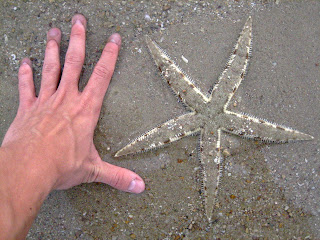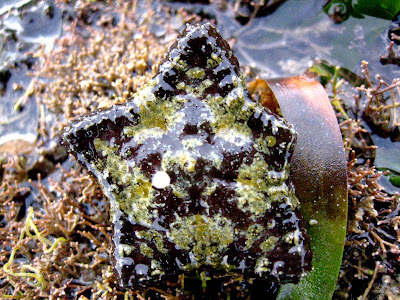:: Ah Cyrene. Just like its mythical namesake from Greek mythogs, where Apollo fell in love with Cyrene, daughter of Hypseus, King of Lapiths, after she wrestled with a lion who attacked her father's sheep. Apollo kidnapped her and founded a city in North Africa (now Libya). And just like he, I too have fallen under the spell of our enchanting Cyrene Reef, right the middle of The Lion City's busy shipping lane. ::
:: Cyrene reef can only be visited a few times a year, at one of the lowest spring tides and only for a few hours. Thus this morning, we mad-capped volunteers, NParks and Dr Lane were there to continue our echinoderm hunt. After the lack of interesting echinoderms on Pulau Semakau on Tuesday, today we found what we were looking for! ::




:: We departed from Singapore Yacht Club in good spirits, all of us raring to down and dirty, looking for echinoderm specimens... ::

:: As the reef is usually fully submerged most of the time, it means it doesn't have a proper landing site. Thus, we would need to make an amphibious landing i.e get wet ::


:: The smaller boat will take us to shore ::


:: Cyrene reef is surrounded by petrochemical refineries and heavy industries on Pulau Bukom & Jurong Island ::


:: Off we go in our dinky little boat ::


:: While some of us suited up, others have already went off in different directions ::








:: Cyrene did not disappoint us. There were so many knobbly sea stars (Protoreaster nodusus) to be found. In all colours, shapes and sizes! ::


:: And common sea stars (Archester typicus) were found all over the sand dune, some of them mating. And big too ::


:: Siti and Weiling found a sea horse (Hippocampus kuda). My first living sea horse on our shores! It was a very pregnant daddy sea horse and refused to have its picture taken ::

:: A sea hare ::


:: Lush sea grass meadows. I have never seen so many species of sea grass before in Singapore, all in one area ::


:: Peacock anemones found here have the most psychedelic colours ::


:: Spotted this long-horned cowfish (Lactoria cornuta) which was utterly adorable. It was swimming around like a wound up toy when it beached itself against the sand. They are related to puffer fishes ::

:: Sea urchins are echinoderms too. Actually, there were plenty of them on Cyrene. Here is a salmacis sea urchin and its dead friend's test ::

:: Black sea urchin (it shall not be named..) with his long spikes and electric blue spots. That ball thing is not its eye which I thought it was, but instead, its the anus. (Imagine having a bulbous anus...no wonder you have spikes) ::

:: So many colony of zoanthids in the sand, all in feeding mode::

:: Lotus coloured jellyfish swam languidly in the shallows::

:: First time seeing a greenish-blue cake star (Anthenea aspera)...one of its arms have been nibbled upon ::

:: I spotted this juvenile cushion star amongst the crystalline algae with one of its limbs bitten off previously and now sporting a smaller appendage ::


:: Anemone shrimp. Usually, a male and female pair can be found living on one carpet anemone ::




:: And the reason why we came to Cyrene...to find this sea star! This is a new recording for Singapore and it was spotted for the first time previously when Team Seagrass came to Cyrene for a session of sea grass monitoring where they spotted it. Luckily, Vyna saved the day and found this as we were heading back to our landing point. This is tentatively known as the...Pentaceraster mammillatus!!!! but we prefer to call it the Evil Knobbly...as compared to its benign red/orange cousins ::


:: And of course, we all turned into star paparazzi ::

:: I didn't realised that there was a tiny brittle star on this synaptid sea cucumber until i got home ::


:: Us going wild over another star of Cyrene...this time its a red feather star or crinoid ::




:: Many coral species can be found on Cyrene. These were found near our landing point ::

:: An encounter with one of Singapore's poisonous crabs, the mosaic crab (Lophozozymus pictor). It is also one of Singapore's threatened animals ::

:: Have never seen such sponges before on our shores, with big gapping holes. I think they are the coolest thing. To think we use them to scrub our backs! ::


:: Two big fat juicy Marginated Glossodoris (Glossodoris atromarginata) nudibranchs feeding (yes, eating) on the tape sea grass. Nudibranchs means naked gills and are actually shell-less molluscs ::


:: Sea grapes. Dr Lane ate one and we all went.." EWWWW" . Sure it can be eaten, but not when its from the waters that surrounds heavy industries. Ha!::

::Lets play Caption time! What is Ria yelling at me for? ::


:: And off we go, heading back to the main boat ::




:: It was an amazing trip to Cyrene, thanks to Ria and everyone else who made it so fun and informative. And just as how Grecian Cyrene needed to wrestle the lion who attacked her sheep, our Cyrene reef is constantly under threat by the impeding doom of being blown up or reclaimed as it is right in the middle of a major shipping lane. Cyrene is also potentially at risk from chemical spills from the petrochemical plants on Pulau Bukom and Jurong Island. And with the monstorus tankers and ships that go by every day, imagine the impact of the waves and currents constantly pounding on the fragile corals and animals found on this marine habitat. ::

:: Sea grapes. Dr Lane ate one and we all went.." EWWWW" . Sure it can be eaten, but not when its from the waters that surrounds heavy industries. Ha!::

::Lets play Caption time! What is Ria yelling at me for? ::


:: And off we go, heading back to the main boat ::




Find out more about Cyrene here!


